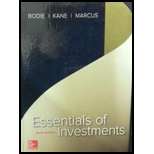
(A)
Adequate Information:
Current price/spot price - $1200
Risk-free interest rate - 2%
Time period to maturity - 1 year
To Compute:
Price of Futures Contract
Introduction:
The price of the futures contract can be calculated usingSpot-Futures parity theorywhich states that if an asset purchased today and held until the maturity of the futures contract, the value of the future contract is equal to the current spot price adjusted for the variables such as interest rate, dividends, time to maturity etc. In simple mathematical equation:
Future price=Spot price X (1 + Risk free interest rate - dividend yield)^ time period in years
(B)
To design
Risk free return strategy to take advantage of future pricing of gold futures contract and compute profits on the strategy.
Introduction:
Risk free return strategy are option strategies where one can sell option on one side and buy option on the other side to get good return.
Given information:
Here spot price of gold futures contract is $1200 and the selling price is $1141. Also, the price of gold futures contract at maturity of 1 year will be $1224.
Explanation:
The spot price is $1200 and selling price is $1141 which means we can sale the gold at $1200 and at the same time buy the gold futures contract at $1141. After one year since the price of this gold futures contract will be $1224 so there will be profit on futures contract bought at$1141 which is ($1224-$1141) $83.
Therefore, the profit on risk free strategy of gold futures contract is $83.
Want to see the full answer?
Check out a sample textbook solution
Chapter 17 Solutions
Essentials of Investments (The Mcgraw-hill/Irwin Series in Finance, Insurance, and Real Estate)
- Inferior Investment Alternatives Although investing requires the individual to bear risk, the risk can be controlled through the construction of diversified portfolios and by excluding any portfolio that offers an inferior return for a given amount of risk. While this concept seems obvious, one of your clients, Laura Spegele, is considering purchasing a stock that you believe will offer an inferior return for the risk she will bear. To convince her that the acquisition is not desirable, you want to demonstrate the trade-off between risk and return. While it is impractical to show the trade-off for all possible combinations, you believe that illustrating several combinations of risk and return and applying the same analysis to the specific investment should be persuasive in discouraging the purchase. Currently, U.S. Treasury bills offer 2.5 percent. Three possible stocks and their betas are as follows: 1. What will be the expected return and beta for each of the following portfolios? a.…arrow_forwardSolve this fin. Qn no aiarrow_forwardYou gave me unhelpful so i also gave you unhelpful.arrow_forward
- What is corporate finance? how many types of corporate finance??arrow_forwardEsfandairi Enterprises is considering a new three-year expansion project that requires an initial fixed asset investment of $2,350,000. The fixed asset will be depreciated straight-line to zero over its three-year tax life, after which time it will be worthless. The project is estimated to generate $3,310,000 in annual sales, with costs of $2,330,000. Assume the tax rate is 23 percent and the required return on the project is 11 percent. What is the project's NPV? Note: A negative answer should be indicated by a minus sign. Do not round intermediate calculations and round your answer to 2 decimal places, e.g., 32.16.arrow_forwardGyygvvv iiiedfarrow_forward
 Essentials Of InvestmentsFinanceISBN:9781260013924Author:Bodie, Zvi, Kane, Alex, MARCUS, Alan J.Publisher:Mcgraw-hill Education,
Essentials Of InvestmentsFinanceISBN:9781260013924Author:Bodie, Zvi, Kane, Alex, MARCUS, Alan J.Publisher:Mcgraw-hill Education,

 Foundations Of FinanceFinanceISBN:9780134897264Author:KEOWN, Arthur J., Martin, John D., PETTY, J. WilliamPublisher:Pearson,
Foundations Of FinanceFinanceISBN:9780134897264Author:KEOWN, Arthur J., Martin, John D., PETTY, J. WilliamPublisher:Pearson, Fundamentals of Financial Management (MindTap Cou...FinanceISBN:9781337395250Author:Eugene F. Brigham, Joel F. HoustonPublisher:Cengage Learning
Fundamentals of Financial Management (MindTap Cou...FinanceISBN:9781337395250Author:Eugene F. Brigham, Joel F. HoustonPublisher:Cengage Learning Corporate Finance (The Mcgraw-hill/Irwin Series i...FinanceISBN:9780077861759Author:Stephen A. Ross Franco Modigliani Professor of Financial Economics Professor, Randolph W Westerfield Robert R. Dockson Deans Chair in Bus. Admin., Jeffrey Jaffe, Bradford D Jordan ProfessorPublisher:McGraw-Hill Education
Corporate Finance (The Mcgraw-hill/Irwin Series i...FinanceISBN:9780077861759Author:Stephen A. Ross Franco Modigliani Professor of Financial Economics Professor, Randolph W Westerfield Robert R. Dockson Deans Chair in Bus. Admin., Jeffrey Jaffe, Bradford D Jordan ProfessorPublisher:McGraw-Hill Education





